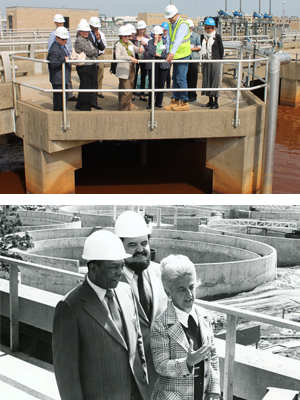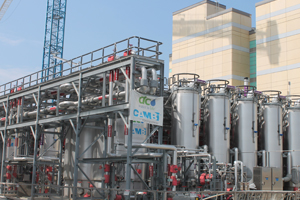Whether it’s used water from a sink a toilet dishwasher or washing machine every day 24-hours a day and 365 days a year that “dirty” water is treated at wastewater plants throughout the metropolitan Washington region. For a great portion of this region almost half of of that wastewater is treated at the Blue Plains Advanced Wastewater Treatment

The tradition of regional leaders taking tours of Blue Plains continues. (Top: Current Chesapeake Bay and Water Resources Policy Committee members; Bottom: First DC Mayor Walter Washington Prince George’s County Supervisor Frank Francois and Fairfax County Supervisor Martha Pennino in this 1970s Washington Post photo.
Plant – located at the southwestern most tip of Washington DC. In fact Blue Plains treats flows from Montgomery County Prince George’s County the District of Columbia Fairfax County and even as far away as Dulles Airport in Loudoun County. What is unusual at Blue Plains unlike most wastewater treatment plants in the United States is that for some portions of the District (one-third) stormwater flows are also captured from city streets and sent to the plant to be treated. This in addition to Blue Plains’ ability to produce such high quality treated water makes it the most advanced wastewater treatment plant in the world.
On Friday September 19 COG’s Chesapeake Bay and Water Resources Policy Committee (CBPC) members met at the plant to hear a briefing by local utility mangers George Hawkins General Manager (DC Water) and Karen Pallansch CEO (Alexandria Renew Enterprises) on a new national study that begins to quantify the tremendous economic impact the water infrastructure sector (i.e. wastewater drinking water and stormwater) has on both jobs and the economy. Hawkins said of DCWater’s improvements to wastewater infrastructure that “we are literally the building the communities we serve” speaking to aesthetic and eco-friendly amenities being installed alongside new wastewater enhancing infrastructure now. The CBPC members were also there to tour the plant and see all the remarkable construction projects and new technologies that are being implemented at Blue Plains.

The machines that will operate the unpictured enormous digester tanks that will help power 1/3rd of the Blue Plains plant.
The stated purpose of our wastewater plants is to protect human health and to improve water quality in local waters the Potomac River and the Chesapeake Bay. At Blue Plains like at all major plants across our region DCWater is embarking on new projects processes and technologies to make themselves even better stewards of the environment to become more energy self-sufficient to ensure the long-term sustainability of their facilities and collection systems and to do so in the most cost-effective manner possible. In fact these utilities of the future are now viewing themselves as resource recovery facilities and are part of a growing effort to address broad environmental improvements. Some of the key projects that the CBPC members viewed at Blue Plains included the expanded nutrient removal process to meet Chesapeake Bay water quality requirements and new sludge digesters which are being seeded with sludge from a facility in Alexandria at time of publishing. These enormous digesters will then be filled with 3.8 million gallons of biosolids which will generate enough methane energy to power 1/3 of the plant and reduce emissions while freeing up energy on the local electrical grid. The materials processed through these new digesters will also be used to produce higher quality end products.
DC Water General Manager Hawkins noted than in addition to the tremendous environmental value that these facilities bring to the region the jobs they provide keeps skills and households within our region while attracting further economic expansion by the private sector. The CBPC members couldn’t agree more with him.